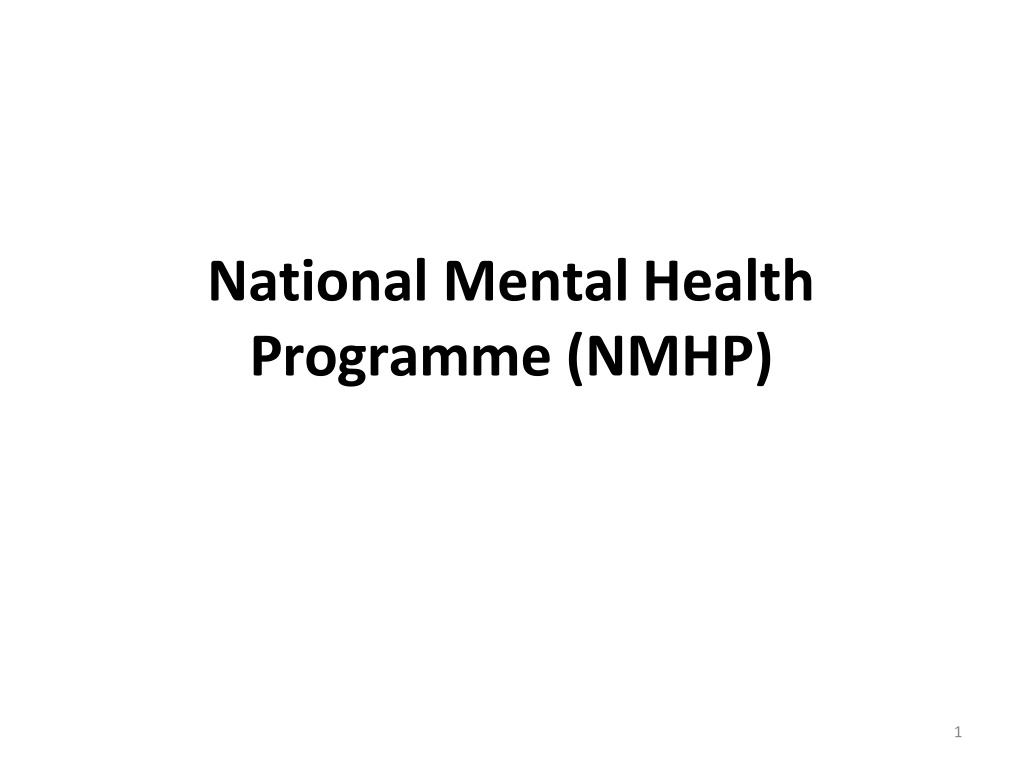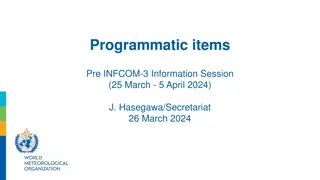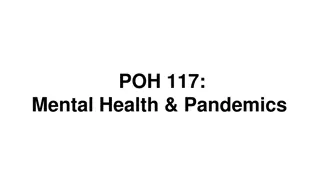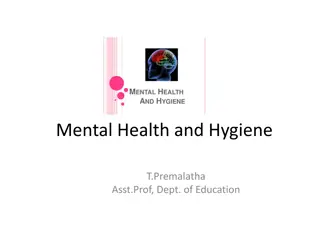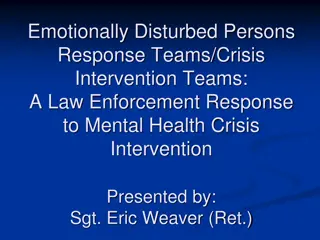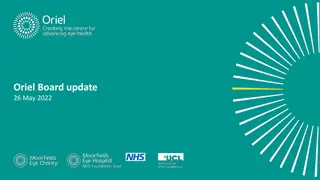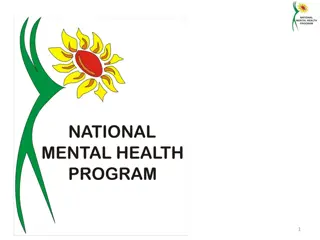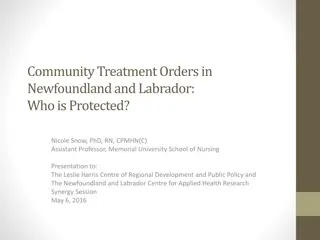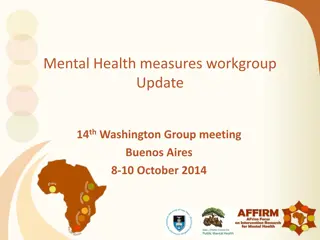National Mental Health Programme (NMHP) Overview
The National Mental Health Programme (NMHP) in India aims to address the unmet needs of mentally ill individuals, focusing on integration with primary health care and improving mental health services. It began in 1982, emphasizing the importance of community-based care over traditional mental hospitals, which were criticized for being custodial rather than therapeutic. The program highlights the significance of achieving mental wellbeing and balance according to WHO definitions.
Download Presentation

Please find below an Image/Link to download the presentation.
The content on the website is provided AS IS for your information and personal use only. It may not be sold, licensed, or shared on other websites without obtaining consent from the author. Download presentation by click this link. If you encounter any issues during the download, it is possible that the publisher has removed the file from their server.
E N D
Presentation Transcript
National Mental Health Programme (NMHP) 1
Mental health is a state of wellbeing characterized by the absence of mental or behaviour disorder whereby the person has made a satisfactory adjustment as an individual, and to the community, in relation to emotional, personal, social and spiritual aspects of there life K.park 2
According to WHO: Mental health has been defined as a state of balance between the individual and the surrounding world, a state of harmony between oneself and others, a coexistence between the realities of the self and that of other people and that of the environment 3
National Mental Health Programme (NMHP) The Beginning As early as 1982, the highest policy making body in the field of health in the country, the Central Council of Health and Family Welfare (CCHFW) adopted and recommended for implementation, a National Mental Health Programme for India (NMHP) 4
Introduction: The national mental health program (NMHP, 1982) is run by the government of India for MEETING THE UNMET NEEDS of the mentally ill people One of the first countries in the developing world to formulate a national mental health program 5
Era of Mental Hospitals Establishment of mental hospitals In 1947- Fifteen mental hospitals with 10,000 beds for 400 million Bhore committee: For 2 beds/1000, 800,000 beds required! QuantitativeGap 6
MentalHospitals Away from the community Dumping ground for the mentally ill Custodial rather than therapeutic Run by wardens rather than doctors Later observations- Poor human rights record Qualitative Gaps 7
Integration: 1975-1982 Efforts at integration of mental health with primary health care Realization that PHC system is the vehicle to take mental health to people Need to train non-professional staff Need to train GP s Need to train more psychiatrists 8
There are at least five important factors which contributed to the drafting of the national mental health programme for India during the early 1980s. 1. The organization of mental health services in developing countries a set of recommendations by an expert committee of the World Health Organization. 2. Starting of a specially designated Community Mental Health Unit at the National Institute of Mental Health and Neuro Sciences (NIMHANS), Bangalore 19756 3.World Health Organization (WHO) Multi-country project: Strategies for extending mental health services into the community (1976-1981) 4. The Declaration of Alma Ata - to achieve Health for All by 2000 by universal provision of primary health care (1978) 5. Indian Council of Medical Research Department of Science and Technology (ICMR-DST) Collaborative project on Severe Mental Morbidity
The organization of mental health services in developing countries a set of recommendations by an expert committee of the WHO Expert Committee set up by the World Health Organization strongly endorsed strategy of integrating mental health into primary care services made recommendations about ways and means of delivering mental health services in developing countries which had acute shortage of trained mental health professionals
Starting of a specially designated Community Mental Health Unit at (NIMHANS), Bangalore 1975 Mental health needs assessment and situation analysis-Rural mental health centre at Sakalwara in Bangalore rural district covering a population of about 100,000 Simple methods of identification and management of persons with mentally illness by primary care personnel. Pilot training programmes in basic mental health care for primary health care (PHC) personnel were conducted Draft manuals of instructions written & pilot tested. CMHU at NIMHANS developed a strategy for taking mental health care to the rural areas through the existing primary health care network
WHO Multi-country project: Strategies for extending mental health services into the community (1976-1981) Model of integrating mental health with general health services and providing basic mental health care by trained health workers and doctors, supported by Multi-country collaborative project initiated by the WHO and carried out in 7 geographically defined areas in 7 developing countries. The department of psychiatry (PGIMER)in Chandigarh was the centre in India and the model was developed in the Raipur Rani block in Haryana state.
Indian Council of Medical Research Department of Science and Technology project on Severe Mental Morbidity During the late 1970s and the early 1980s, ICMR and the Department of science and Technology (DST) ,Government of India funded a 4 centre collaborative study to evaluate the feasibility of training PHC staff to provide mental health care as part of their routine work. (ICMR-DST) Collaborative Evaluation was carried out for 1 year covering a population of 40, 000 in a PHC at four centres, one each from the South, North, East and West of the country, Bangalore, Patiala, Calcutta and Baroda. At the end of one year period about 20% of the actual cases were identified and managed by the PHC personnel under the overall supervision of the centre staff
The above factors contributed in drafting of the NMHP. consisted of some of the leading, senior psychiatrists in India reviewed and revised in two national workshops attended by a large number of mental health professionals and other stakeholders during 1981-82, adoption by the Central Council of Health and Family Welfare (CCHFW) in August1982 The Government of India has launched the National Mental Health Programme (NMHP) in 1982 The draft of the NMHP, written by an expert drafting committee
Aims 1.Prevention and treatment of mental and neurological disorders and their associated disabilities. 2. Use of mental health technology to improve general health services. 3. Application of mental health principles in total national development to improve quality of life.
Objectives 1)To ensure availability and accessibility of minimum mental health care for all in foreseeable future, particularly most vulnerable and underprivileged section of population
Objectives 2)Encourage application of mental health knowledge in general health care and social development 3)Promote community participation in mental health services development and stimulate efforts towards self-help in community
Strategies 1.Integration mental health with primary health care through the NMHP 2. Provision of tertiary care institutions for treatment of mental disorders 3.Eradicating stigmatization of protecting their rights through regulatory institutions like the Central Mental Health Authority and State Mental health Authority. mentally ill patients and
Specific Approaches Diffusion of mental health skills to the periphery of health services Appropriate appointment of tasks Equitable and balanced distribution of resources Integration of basic mental health care with general health services Linkage with community development
Goals of NMHP Within one year- Each state will have adopted the plan Govt of India will have appointed a focal point within the ministry of health specifically for MH action National coordinating group will be formed comprising reps of each state, senior health adm, professionals from psychiatry, social welfare and education
Goals of NMHP Task force will have worked out outlines curriculum of mental health workers and for MO s at PHC level Within 5 years- 5000 of target non-medical professionals will have undergone 2 weeks training in mental healthcare
Goals of NMHP Creation of a post of psychiatrist in at least 50% of districts Psychiatrist at the district level will visit all the PHC s regularly at least once a month for supervision and education To be fully operational in at least half of all districts in some states and UT
Goals of NMHP Each state will appoint a program officer responsible for organization and supervision of mental health program Each state will provide additional support for incorporating common mental health components in teaching curricula Appropriate psychotropic drugs to be made essential drugs and available at PHC level
Goals of NMHP Psychiatric units with in-patient facility will be made available in all medical college hospitals in the country
Strengths: Proposed mutually synergistic integration of mental health care with primary health care Proposed to use PH machinery Integration of all aspects of teaching, research and therapeutics
Achievements in Initial Years: Workshops for mental health professionals, health directorate officials were held, sensitization to mental health issues Preparation of support materials in form of manuals, health records and health education materials with inputs from NIMHANS, CIP and PGIMER Training for teachers in psychiatry
What happened after1982 Adoption of achievement the national mental health programme was a great No budgetary estimates or provisions Lack of clarity regarding who should fund the programme the federal government of India or the state governments who perpetually had inadequate funds for healthcare. A very lukewarm response and in some instances, almost rejection of the programme by psychiatrists. Doubts were expressed about the feasibility of implementing the programme in larger populations and in real world settings Issues left unclear
Barriers to the Implementation of NMHP Limited undergraduate training in psychiatry Inadequate mental health human resources Lack of policy driven epidemiological data and research driven mental healthcare policies Limited number of models and their evaluation Uneven distribution of resources across states Non-implementation of the MHA, 1987 Privatization of healthcare in the 1990s.
Weaknesses Emphasis on curative rather than promotive or preventive aspects of mental health Community resources like family was not given due importance No clear cut model for macro implementation
1982-1990 Development of the pilot district mental health programme at Bellary districtin Karnataka NIMHANS developed a program to operationalize and implement the NMHP in adistrict. population of about 20lakhs, located about 350 kms away from Bangalore chosen for the pilot development of a (DMHP). Bellary district ,
Components of the DMHP at Bellary were: training for all primary care staff, provision of 6 essential psychotropic and anti epileptic drugs (chlorpromazine, amitryptaline, trihexyphenidyl, injection fluphenazine deaconate, phenobarbitone and diphenyl hydantoin) at all PHCs and sub centres, a system of simple mental heath case records, a system of monthly reporting, regular monitoring and feed back from the district level mental health team
mental health clinic at the district hospital to review patientsreferred from the PHCs. admit up to 10 patients at the district hospital for brief in patient treatment. The psychiatrist The mental health programme was reviewed every month at the district level by the district health officer during the monthly meeting of primary health centre medical officers
The Ministry of Health and Family Welfare, Govt. of India formulated District Mental Health Programme (under National Mental Health Programme) The programme was to be implemented in two phases, Phase I taken up during 1996-97, Phase II be a continuation of the programme during the IX Five YearPlan period (1997-2002). budget line for implementation of the DMHP as a major component of the NMHP was created in 1996; 14 years after CCHFW approved the NMHP. DMHP was to be implemented as a fully centrally supported project
Launched in 199697 in four districts, one each in Andhra Pradesh, Assam, Rajasthan, and Tamil Nadu At present the program is in place in 127 districts DMHP is also being started in 325 new districts The central grant for implementation of DMHP per district with avg population of 20 lakh for five years will be Rs. 2.5 crore 35
DMHP Objectives: 1. To Provide sustainable basic mental health services in community and integration of these with other services 2. Early detection and treatment in community itself 3. To ensure ease of care givers 4. To take pressure off mental hospitals 5. To reduce stigma 6. To rehabilitate patients within the community 7. To detect ,manage & refer cases of epilepsy
Components of DMHP 1. Training of medical, paramedical personnel and community leaders 2. Community Mental Health care through existing infrastructure of the health services 3. Information, Education and Communication (IEC) activities
DMHPKey Features 1. The States will set in motion the process of finding suitable personnel for manning the DMHP teams. They can take in service candidates who are willing to serve in this pilot project and provide them the necessary training in the identifiedinstitution 2. 3. The patients will be from the district itself and the adjoining areas 4. District Mental Health Team will be expected to provide service to the needy mentally ill patients and their families, such as daily out-patient service, ten bedded in-service facilities, referral service and liaison with the primary health centres, follow up service, awareness programmes, and also community survey if feasible. 38
The DMHP Provide valuable data & experience at the level of community to the state & centre for future planning & improvement in service & research.
The team of workers at the district under the program consists of a Psychiatrist, ClinicalPsychologist, Psychiatric Social worker, Psychiatry/Community Nurse, ProgramManager, Program/Case Registry Assistantand RecordKeeper.
STAFF NUMBER SALARY Program Officer( P.O.) 1(Psychiatrist/ Medical officer on deputation or on contract) Psychiatrist -Rs 50,000/- Trained medical officer- Rs 30,000/- Psychiatric Social Worker/ Social Worker 1( on contract) Psychiatric social worker( Mphil- PSW)-Rs30,000/-, Trained medical social worker Rs 18,000/- Clinical Psychologist/ Psychologist 1( on contract) Clinical psychologist( Mphil-Cl.Psychology)-Rs 30,000/- Trained Psychologist( MA Psychology)- Rs 18,000/- Psychiatric Nurse/ Trained General Nurse 1( on contract) Psychiatric Nurse(MSc.- Psych.Nursing or DPN)- Rs 25000/- General Nurse-Rs15000/- Record Keeper 1( on contract) Rs 10000/- (Graduate) with suitable experience
CommunityNurse ( Case Manager) 1( on contract) for keeping a record of all severe mentally ill. Rs 25000/- ( Trained General Nurse with administrative experience) Rs 8000/-(12th + proficieny in computers and office work) Case Registry Assistant 1( on contract) for assisting the programme manager Total 5 member technical team+ 2 member administrative team
The top down-bottom up approach Look after mental patients who need prolonged in-patient care State Mental Hospital Diagnose and manage difficult cases Return the cases to community as soon as possible District Hosp/Medical college Psychiatric team Diagnose and manage typical cases Refer difficult cases to District team Monitor the follow-up of the patients on treatment PHC Doctors Multipurpose workers at the PHC Detect cases in the community Refer cases to PHC Conduct simple mental health education of the community Follow-up the patients regularly Epileptics and Psychiatric patients in the community
2002 to 2007 - X Five Year Plan period The NMHP was re-strategized in the year 2003 (in X Five Year Plan) with the following components: 1. Extension of DMHP to 100 districts 2. Up gradation of Psychiatry wings of Government Medical Colleges/ General Hospitals 3. Modernization of State Mental hospitals 4. IEC 5. Monitoring & Evaluation
Modernization of State Run MentalHospitals The assistance under this scheme is provided for modernization of state run mental hospitals from custodial care to comprehensive management. A one-time grant with a ceiling of Rs.3.00 crores per hospital is provided. The grant covers activities such as construction/repair of existing building(s), purchase of cots and equipments, provision of infrastructure such as water- tanks and toilet facilities etc. Does not cover recurring expenses towards running the mental hospitals and cost towards drugs and consumables. Grant is for modernization of the mental hospitals only and any increase in the number of beds in the hospital is notpermitted.
Up gradation of Psychiatric Wings of Medical Colleges/General Hospitals Every medical college should ideally have a Department of Psychiatry with minimum of three faculty members and inpatient facilities of about 30 beds as per the norms laid down by the MCI scheme for strengthening of the psychiatric wings of government medical colleges/hospitals which provides for a one-time grant of Rs.50 lakhs for up gradation of infrastructure and equipment as per the existing norms. aim of the scheme is to strengthen the training facilities for UG& PG at Psychiatry wings of government medical colleges/hospitals. grant covers construction of new ward, repair of existing ward, procurement of items like cots, tables and equipments for psychiatric use such as modified ECTs.
IEC Activities NMHP has dedicated funds for IEC activities for the purposeof increasing awareness and removal of stigma for mental illness. The funds are allocated at central and state levels for IEC activities. An amount of Rs. 25 crore is allocated for the purpose of IEC activities at central level.
2007 onwards - IX Five Year Plan, The current phase In the XI Five Year Plan, the NMHP has the following components/schemes: 1. District Mental Health Programme (DMHP) 2. Manpower Development Schemes - Centers Of Excellence And Setting Up/ Strengthening PG Training Departments of Mental Health Specialities 3. Modernization Of State Run Mental Hospitals 4. Up gradation of Psychiatric Wings of Medical Colleges/GeneralHospitals 5. IEC 6. Training & Research 7. Monitoring & Evaluation Manpower Development Schemes - Centers of Excellence and Setting Up/ Strengthening PG Training Departments of Mental Health Specialities are the new schemes/components.
manpower Development Scheme To improve the training infrastructure in mental health, Government of India has approved the Manpower Development Components of NMHP for XIth Five Year Plan. It has two schemes which are as follows: A. Centers of Excellence (Scheme A) B. Setting Up/ Strengthening PG Training Departments of Mental Health Specialities (Scheme B)
A. Centres of Excellence (Scheme A) Under Scheme-A, at least 11 Centres of Excellence in mental health were to be established in the IXth plan period by upgrading existing mental health institutions/hospitals. A grant of up to Rs.30 crores is available for each centre The commitment to take over the entire funding of the scheme after the 11th five year plan period from the state government is required. The proposal of the State Governments for these centres must include definite plan with timelines for initiating/ increasing PG courses in Psychiatry, Clinical Psychology, PSW and Psychiatric Nursing.
B. Setting Up/ Strengthening PG Training Departments of Mental Health Specialities (Scheme B) To provide further impetus to manpower development in Mental Health, Government Medical Colleges/ Hospitals are supported to start PG courses in Mental Health or to increase the intake capacity for PG training in Mental Health. The support involves capital work for establishing/improving mental health departments (Psychiatry, Clinical Psychology, Psychiatric Social Work, and Psychiatric Nursing), equipments, tools and basic infrastructure, support for engaging required/deficient faculty for starting/enhancing the PG courses. The support of up to Rs. 51 lacs to Rs. 1 crore per PG department is available.
